
Lee Bontecou is among my favorite living artists, so it was with great pleasure that I spent an afternoon at the MoMA exhibition "Lee Bontecou: All Freedom in Every Sense." I must admit that I was disappointed when I found that the exhibition was in the one-room gallery-cum-hallway of the fourth floor just at the entrance of the permanent painting and sculpture galleries (perhaps they felt that she got her fair share of space in the 2004 retrospective at the MoMA's temporary Queens location). But Bontecou's work could be displayed in let's say, to make my point, a hideous-smelling former meatpacking plant and I'd still be in awe.
MoMA's wall text on the show:
Lee Bontecou (born Providence, Rhode Island, 1931) first exhibited her steel-and- canvas sculptures at New York's prominent Leo Castelli Gallery in the 1960s. [...] These wall-mounted sculptures--made in New York between 1959 and 1967--elicited both critical acclaim and curiosity. Bontecou's imaginative vision encompasses all of these possibilities. For decades she has left her work untitled, preferring not to restrict the ways in which it may be understood.
Bontecou's excitement about the Space Age and her memories of the Second World War are fundamental to her visual language. While her art defies easy classification, suggestions of infinite expanse, anxiety, and threat are pervasive, expressed, for example, in the black circular forms that have been insistent motifs in her work. The cavernous black voids of her steel-and-canvas sculptures and the deep black circles of her drawings conjure associations as varied as volcanic craters, jet engines, eye sockets, and cosmic black holes, invoking what the artist has described as "the visual wonders and horrors" of the natural and man-made worlds.
In 1971 Bontecou left New York City. Since then she has worked primarily in rural Pennsylvania, where her engagement with the natural world has become more pronounced. The sculpture suspended at the center of this installation--a slowly whirling galaxy of forms she worked on for eighteen years--represents a fulfillment of her longstanding desire to create art that celebrates "as much of life as possible-- no barriers--no boundaries--all freedom in every sense."
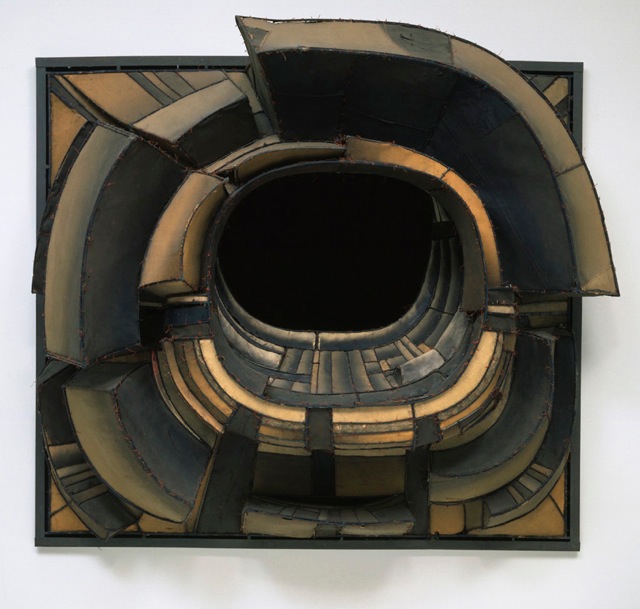
Untitled, 1961.
Welded steel, canvas, black fabric, rawhide, copper wire, and soot, 6' 8 1/4" x 7' 5" x 34 3/4".
The Museum of Modern Art, New York. Kay Sage Tanguy Fund
Unfortunately the very flat images provided by the MoMA don't do this work justice (but Google Image search her to see more images). In this work, the details of the stitching, the tactile and discolored canvas--that were apparently taken from conveyor belts discarded by a laundry below Bontecou's East Village apartment at the time--and the chilling black orifice in the central part of the relief work all at once terrifying, hypnotizing, and sensual. I love how artist Joseph Cornell described these gaping black cavities as summoning "the terror of the yawning mouths of cannons, of violent craters, of windows opened to receive your flight without return, and the jaws of the great beasts." I suppose only someone with an equally wonderful artistic mind could describe her work in such a poetic and absolutely chilling way.
An excerpt from the placard next to this work reads:
The year Bontecou made this work was marked by intense anxiety: the Bay of Pigs invasion of Cuba failed, the United States committed its first troops to Vietnam, and the construction of the Berlin Wall began. Although Bontecou rarely comments on her art, in a statement that accompanied a 1963 MoMA exhibition featuring this work, she wrote, "My concern is to build things that express our relation to this country--to other countries--to this world-- to other worlds . . . to glimpse some of the fear, hope, ugliness, beauty and mystery that exists in us all and which hangs over all the young people today."
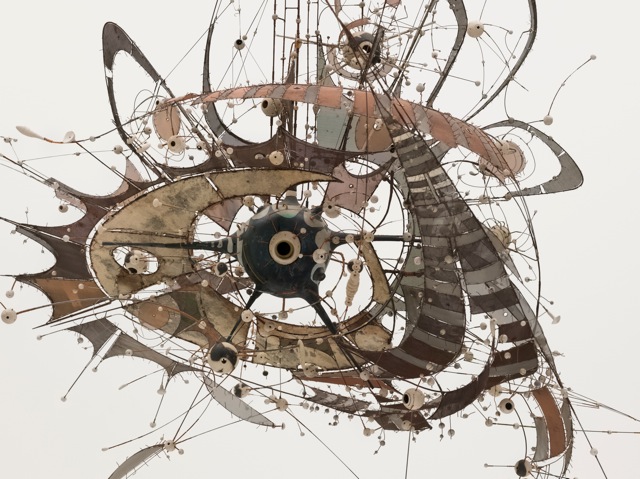
Detail of Untitled, 1980-98. Welded steel, porcelain, wire mesh, canvas, grommets, and wire, 7 x 8 x 6'.
The Museum of Modern Art, New York. Gift of Philip Johnson (by exchange) and the Nina and Gordon Bunshaft Bequest Fund
This monumental work suspended from the center of the gallery took Bontecou 18 years to finish. It is made of welded steel, porcelain globes, wire mesh, canvas, grommets and piano wire. A shadow creeps and dances along the white platform on the floor. The work feels endless, like it will go on forever, eventually reaching out in the space--into the orbital that it is inspired by. It feels futuristic and primordial, optimistic and daunting, all at once. The artist described her excitement in Sputnik, the first man-made satellite which launched from the earth in 1957 and was an inspiration to this and many other of Bontecou's works:
"I had joy and excitement about outer space--nothing was known about back holes--just huge, intangible, dangerous entities, and I felt excitement when little Sputnik flew."
But perhaps the works that affected me the most on this particular visit were her soot on paper works. Bontecou discovered this rich, velvety, otherworldly black when she adjusted the oxygen levels on her blowtorch so that soot poured out. She began to draw with the torch. It is the most intense and immediate black that I have ever encountered. Bontecou said, as stated on the placard: "I finally got the black I wanted and a kind of landscape or 'worldscape.'" On another placard next to an incredible soot oval, it explains that she would use her fingers to soften the edges in some areas and applied tape to create crisp edges in other areas. These drawings were precursors to her steel-and-canvas works. (Unfortunately no images of these works were provided but you can see them, and other images from the show, on this blog post I found)
Also in the show are some surreal and fantastical pencil and pen on paper works and lithographs. The subject matter looks as if it was taken from a young boy's sketchbook -- they attest to her obsession with outer space and airplanes. (I saw the show with friend and artist Alejandro Cardenas, who commented that they looked like his sketchbooks growing up; he, too, was amazed at her vivid and fantastical imagination that spanned her 50-plus-year career.) The curator of the show, Veronica Roberts, said that Bontecou used to visit Idlewild Airport (now called JFK Airport) and has talked about the thrill of watching planes land and take off there.

Tenth Stone, 1968. Lithograph irreg composition, 37 11/16 x 22 3/8", sheet 41 1/8 x 27 15/16".
The Museum of Modern Art, New York. Gift of the Celeste and Armand Bartos Foundation
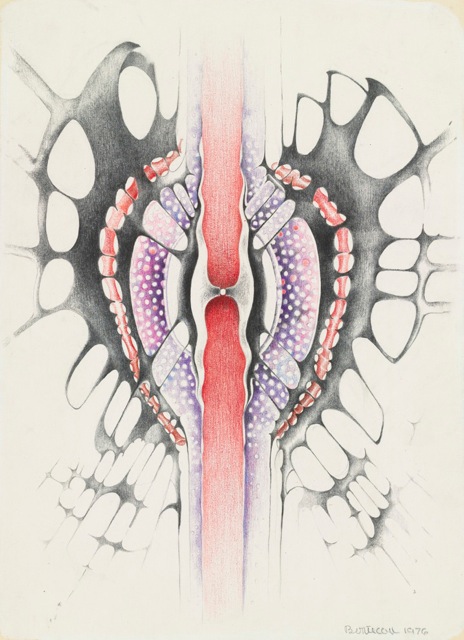
Untitled, 1976. Pencil and colored pencil on prepared paper 15 x 11".
The Museum of Modern Art, New York. The Judith Rothschild Foundation Contemporary Drawings Collection Gift
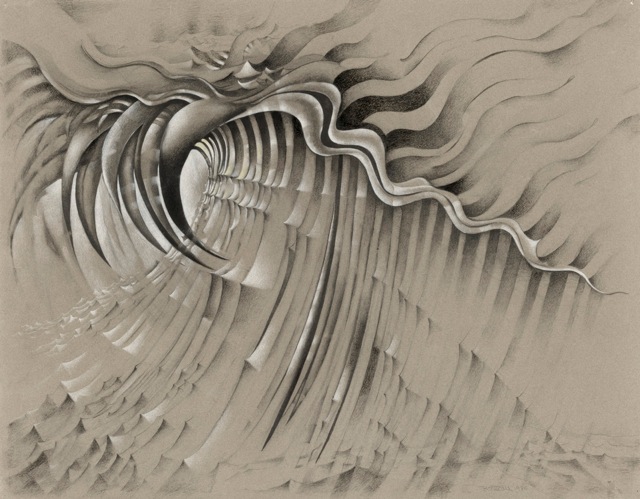
Untitled, 1985. Charcoal, pencil, and colored pencil on colored paper 22 x 30".
The Museum of Modern Art, New York. The Judith Rothschild Foundation Contemporary Drawings Collection Gift
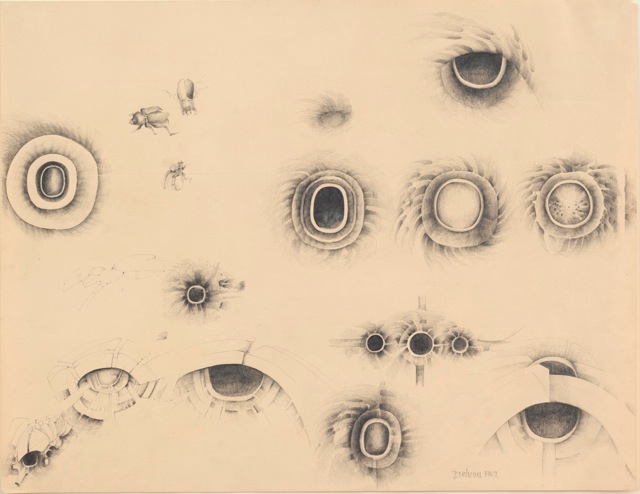
Untitled, 1962. Pencil on paper 19 3/4 x 25 1/2".
The Museum of Modern Art, New York. Gift of Sally and Wynn Kramarsky
The fact that this petite woman was creating these dynamic, larger-than-life sculptures and works is gratifying to me, perhaps because I'm also considered small in stature, though I don't feel "small" in my thoughts or emotions. It reminds me of something that Louise Bourgeois said in the documentary The Spider, The Mistress and The Tangerine, which affected me deeply: "My emotions are inappropriate to my size."
Through September 6, at the Museum of Modern Art.